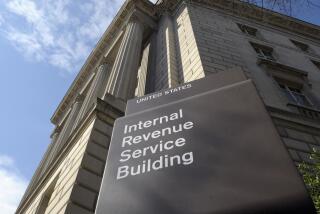What to Look for When Bunching Deductions
Q: Year-end tax advice always suggests bunching and spacing deductible payments to get the best deal when we file a tax return. I want to do that to qualify for filing an itemized income tax return. I am thinking of bunching two years’ in tax payments in a single year. Can you evaluate the wisdom of my plan, as well as its legality? --G. S. B.
A: Your scheme is perfectly legal, but whether it makes financial sense--or even common sense--is another matter.
Let’s review your plan. Every other year you would pay two years’ worth of property taxes to accumulate enough deductions to itemize them on your tax return. In the “off year,” you would take the standard deduction.
To carry this out, you will have to delay paying the property tax installment normally due in December until the following month. For this you will incur a 10% penalty. Then you would pay the April installment and that for the following December on time.
Finally, you would prepay the installment due the following April by year-end, before its due date. When you pencil out the mathematics of your plan, be sure to figure in the 10% penalty on the first installment as well as the interest lost on the final installment. Somehow, you should find a way to figure in all the trouble you are going through.
When financial advisers and tax planners talk about bunching deductions and scheduling expenses to take maximum value of the tax calendar, they are usually talking about elective and extraordinary expenses, and about incomes that fluctuate greatly from year to year.
They aren’t usually talking about accumulating run-of-the-mill property tax payments to make an itemized income tax filing once every two years. If you really want to itemize your deductions, you can surely find other ways far less convoluted. For example, you can increase the amount you give to charity.
Or, if you can stand the burden of extra debt, you can increase the mortgage on your home through a refinancing to give yourself more deductible interest.
Before you choose a plan to generate more deductions, you should work through the tax computations carefully to make sure that all your efforts will save you money. You may find that you are better off--financially and emotionally--when you are make regular property tax payments every year and take the standard deduction.
How Citizenship Can Affect Step-Up Value
Q: I am a Canadian citizen married to an American. I have stocks in my own name that I owned before I married and that I have been given since the marriage. If I should survive my husband, would I get a stepped-up basis on the value of my portfolio at the time of his death? --J.B.
A: It depends on a couple of factors. No. 1, and most important, you would have to make those stocks part of your marriage’s community property. Only assets held as community property are entitled to a step-up in value upon the death of one spouse. To make those stocks a part of your community property, simply give a half interest in them to your husband, an easy enough task in most marriages.
However, in the case of a marriage between a U.S. citizen and a non-citizen, the issue becomes more complicated. And this is the second factor you must consider. The law normally allows unlimited gifts between spouses--if both are U.S. citizens. But in cases where one spouse is not a citizen, the limit on gifts between spouses is $100,000 per year.
If you can meet that test--it would not seem difficult unless you are extraordinarily wealthy--you can make the stocks part of your community property. That way you can achieve a step-up in their value upon the death of one spouse.
Student Loan Should Be Paid Off Quickly
Q: My daughter recently graduated from college and will soon begin repaying student loans totaling $50,000. The loans are scheduled to be repaid at 7% interest over 10 years, but my daughter is considering a repayment plan offering 9% interest over a 20-year period. Her thought is to invest the extra money she does not repay each month. Can you advise as to the wisdom on this move? --M.L.
A: First, let’s do the math. A $50,000 loan at 7% interest repaid in monthly installments over 10 years would cost $69,600, with monthly payments of about $580, according to calculations performed for us by Torrance financial planner Thomas Gau. A $50,000 loan at 9% interest repaid in monthly installments over 20 years would cost a total of $108,000, with monthly payments of about $450.
What can we learn from this? Well, for repaying about $130 more each month--or $1,560 each year--for 10 years, your daughter can save $38,400 in interest charges.
By the way, your daughter would have to work magic with her investments to earn the return necessary to offset the cost of paying 9% non-deductible interest on her student loans. (Remember, the interest paid on student loans is considered the same as personal or consumer interest. It is not deductible on federal or state income taxes.)
Your daughter should be able to see that she is far better off repaying her student loans as quickly as possible and waiting until she is debt-free to begin investing for the future.
More to Read
Inside the business of entertainment
The Wide Shot brings you news, analysis and insights on everything from streaming wars to production — and what it all means for the future.
You may occasionally receive promotional content from the Los Angeles Times.










